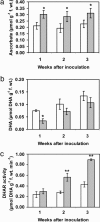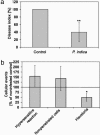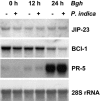The endophytic fungus Piriformospora indica reprograms barley to salt-stress tolerance, disease resistance, and higher yield
- PMID: 16174735
- PMCID: PMC1224632
- DOI: 10.1073/pnas.0504423102
The endophytic fungus Piriformospora indica reprograms barley to salt-stress tolerance, disease resistance, and higher yield
Abstract
Disease resistance strategies are powerful approaches to sustainable agriculture because they reduce chemical input into the environment. Recently, Piriformospora indica, a plant-root-colonizing basidiomycete fungus, has been discovered in the Indian Thar desert and was shown to provide strong growth-promoting activity during its symbiosis with a broad spectrum of plants. Here, we report on the potential of P. indica to induce resistance to fungal diseases and tolerance to salt stress in the monocotyledonous plant barley. The beneficial effect on the defense status is detected in distal leaves, demonstrating a systemic induction of resistance by a root-endophytic fungus. The systemically altered "defense readiness" is associated with an elevated antioxidative capacity due to an activation of the glutathione-ascorbate cycle and results in an overall increase in grain yield. Because P. indica can be easily propagated in the absence of a host plant, we conclude that the fungus could be exploited to increase disease resistance and yield in crop plants.
Figures





Similar articles
-
A proteomics approach to study the molecular basis of enhanced salt tolerance in barley (Hordeum vulgare L.) conferred by the root mutualistic fungus Piriformospora indica.Mol Biosyst. 2013 Jun;9(6):1498-510. doi: 10.1039/c3mb70069k. Epub 2013 Apr 2. Mol Biosyst. 2013. PMID: 23545942
-
Proteomics study reveals the molecular mechanisms underlying water stress tolerance induced by Piriformospora indica in barley.J Proteomics. 2013 Dec 6;94:289-301. doi: 10.1016/j.jprot.2013.09.017. Epub 2013 Oct 11. J Proteomics. 2013. PMID: 24120527
-
The root endophytic fungus Piriformospora indica requires host cell death for proliferation during mutualistic symbiosis with barley.Proc Natl Acad Sci U S A. 2006 Dec 5;103(49):18450-7. doi: 10.1073/pnas.0605697103. Epub 2006 Nov 20. Proc Natl Acad Sci U S A. 2006. PMID: 17116870 Free PMC article.
-
Molecular mechanism underlying Piriformospora indica-mediated plant improvement/protection for sustainable agriculture.Acta Biochim Biophys Sin (Shanghai). 2019 Mar 1;51(3):229-242. doi: 10.1093/abbs/gmz004. Acta Biochim Biophys Sin (Shanghai). 2019. PMID: 30883651 Review.
-
Opprimo ergo sum--evasion and suppression in the root endophytic fungus Piriformospora indica.Mol Plant Microbe Interact. 2012 Jun;25(6):727-37. doi: 10.1094/MPMI-11-11-0291. Mol Plant Microbe Interact. 2012. PMID: 22352718 Review.
Cited by
-
Fungal endophyte Penicillium janthinellum LK5 improves growth of ABA-deficient tomato under salinity.World J Microbiol Biotechnol. 2013 Nov;29(11):2133-44. doi: 10.1007/s11274-013-1378-1. Epub 2013 Jul 11. World J Microbiol Biotechnol. 2013. PMID: 23842755
-
Soil Application of a Formulated Biocontrol Rhizobacterium, Pseudomonas chlororaphis PCL1606, Induces Soil Suppressiveness by Impacting Specific Microbial Communities.Front Microbiol. 2020 Aug 7;11:1874. doi: 10.3389/fmicb.2020.01874. eCollection 2020. Front Microbiol. 2020. PMID: 32849458 Free PMC article.
-
Optimal culture conditions of Piriformospora indica for volatile compound release to promote effective plant growth.Plant Biotechnol (Tokyo). 2023 Mar 25;40(1):117-121. doi: 10.5511/plantbiotechnology.22.1221a. Plant Biotechnol (Tokyo). 2023. PMID: 38213916 Free PMC article.
-
Plant-associated halotolerant bacteria improving growth of Vicia faba L. Mariout-2 under salinity conditions.Sci Rep. 2024 Jul 20;14(1):16737. doi: 10.1038/s41598-024-66504-0. Sci Rep. 2024. PMID: 39033227 Free PMC article.
-
Profundae diversitas: the uncharted genetic diversity in a newly studied group of fungal root endophytes.Mycology. 2015 Jul 24;6(3-4):139-150. doi: 10.1080/21501203.2015.1070213. eCollection 2015. Mycology. 2015. PMID: 30151322 Free PMC article.
References
-
- Food and Agriculture Organization of the United Nations (2004) The State of Food and Agriculture 2003-04, www.fao.org/documents/show_cdr.asp?url_file=/docrep/006/Y5160E/Y5160E00.HTM.
-
- Chapin, F. S., III, Zavaleta, E. S., Eviner, V. T., Naylor, R. L., Vitousek, P. M., Reynolds, H. L., Hooper, D. U., Lavorel, S., Sala, O. E., Hobbie, S. E., et al. (2000) Nature 405, 234-242. - PubMed
-
- Parmesan, C. & Yohe, G. (2003) Nature 421, 37-42. - PubMed
-
- Newman, E. I. & Reddell, P. (1987) New Phytol. 106, 745-751. - PubMed
-
- Azcón-Aguilar, C. & Barea, J. M. (1996) Mycorrhiza 6, 457-464.
Publication types
MeSH terms
Substances
LinkOut - more resources
Full Text Sources
Other Literature Sources

